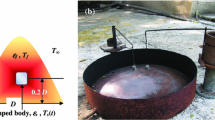Abstract
Buoyancy production rates for a pure heat source and for a fire heat source of burning woody fuels show that fire may be regarded as a pure source yielding heated air rather than heated combustion products.
Similar content being viewed by others
References
Byram, G. M., Clements, H. B., Bishop, M. E., and Nelson, R. M., Jr., “An Experimental Study of Model Fires,” Final Report, Project Fire Model, U. S. Forest Service, Southeastern Forest Experiment Station (June 1, 1966), 51 pp.
Scorer, R. S.,Buoyant Convection (Pergamon Press, New York, 1958), p. 175.
Countryman, Clive M., “Mass Fires and Fire Behavior,” U. S. Forest Service Research Paper PSW-19, Pacific Southwest Forest and Range Experiment Station (1964), 53 pp.
Byram, George M. and Nelson, Ralph M. Jr., “The Modeling of Pulsating Fires,”Fire Technology, Vol. 6, No. 2 (May 1970), pp. 102–110.
Byram, George M., “Combustion of Forest Fuels,” inForest Fire: Control and Use, K. P. Davis (ed.) (McGraw-Hill Book Co., Inc., New York, 1959), Chapter 3, p. 63.
Author information
Authors and Affiliations
Rights and permissions
About this article
Cite this article
Byram, G.M., Nelson, R.M. Buoyancy characteristics of a fire heat source. Fire Technol 10, 68–79 (1974). https://doi.org/10.1007/BF02590513
Issue Date:
DOI: https://doi.org/10.1007/BF02590513




